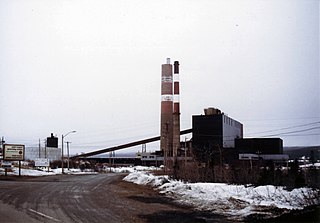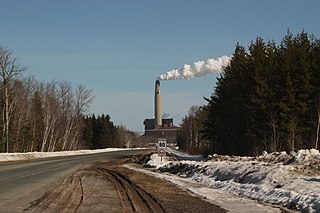
A power station, also referred to as a power plant and sometimes generating station or generating plant, is an industrial facility for the generation of electric power. Power stations are generally connected to an electrical grid.

The Manitoba Hydro-Electric Board, operating as Manitoba Hydro, is the electric power and natural gas utility in the province of Manitoba, Canada. Founded in 1961, it is a provincial Crown Corporation, governed by the Manitoba Hydro-Electric Board and the Manitoba Hydro Act. Today the company operates 16 interconnected generating stations. It has more than 527,000 electric power customers and more than 263,000 natural gas customers. Since most of the electrical energy is provided by hydroelectric power, the utility has low electricity rates. Stations in Northern Manitoba are connected by a HVDC system, the Nelson River Bipole, to customers in the south. The internal staff are members of the Canadian Union of Public Employees Local 998 while the outside workers are members of the International Brotherhood of Electrical Workers Local 2034.

A fossil fuel power station is a thermal power station which burns a fossil fuel, such as coal, oil, or natural gas, to produce electricity. Fossil fuel power stations have machinery to convert the heat energy of combustion into mechanical energy, which then operates an electrical generator. The prime mover may be a steam turbine, a gas turbine or, in small plants, a reciprocating gas engine. All plants use the energy extracted from the expansion of a hot gas, either steam or combustion gases. Although different energy conversion methods exist, all thermal power station conversion methods have their efficiency limited by the Carnot efficiency and therefore produce waste heat.

New Brunswick Power Corporation, operating as NB Power, is the primary electric utility in the Canadian province of New Brunswick. NB Power is a vertically-integrated Crown corporation by the government of New Brunswick and is responsible for the generation, transmission, and distribution of electricity. NB Power serves all the residential and industrial power consumers in New Brunswick, with the exception of those in Saint John, Edmundston and Perth-Andover who are served by Saint John Energy, Energy Edmundston, and the Perth-Andover Electric Light Commission, respectively.

The electricity sector in Canada has played a significant role in the economic and political life of the country since the late 19th century. The sector is organized along provincial and territorial lines. In a majority of provinces, large government-owned integrated public utilities play a leading role in the generation, transmission, and distribution of electricity. Ontario and Alberta have created electricity markets in the last decade to increase investment and competition in this sector of the economy.

A thermal power station, also known as a thermal power plant, is a type of power station in which the heat energy generated from various fuel sources is converted to electrical energy. The heat from the source is converted into mechanical energy using a thermodynamic power cycle. The most common cycle involves a working fluid heated and boiled under high pressure in a pressure vessel to produce high-pressure steam. This high pressure-steam is then directed to a turbine, where it rotates the turbine's blades. The rotating turbine is mechanically connected to an electric generator which converts rotary motion into electricity. Fuels such as natural gas or oil can also be burnt directly in gas turbines, skipping the steam generation step. These plants can be of the open cycle or the more efficient combined cycle type.

Orot Rabin is a power station located on the Mediterranean coast in Hadera, Israel which is owned and operated by the Israel Electric Corporation (IEC). As of 2022 it is Israel’s largest power station and contains six thermal generation units capable of producing a total of 2.59GW of electricity using coal as the primary fuel. In addition, under construction at the site are two single-shaft natural gas-powered combined-cycle units capable of generating 630 MW each. The older, unmodernised four of its total six coal-fuelled units will be closed by mid-2022 in order to eliminate this major source of air pollution in the country.

Canada has access to all main sources of energy including oil and gas, coal, hydropower, biomass, solar, geothermal, wind, marine and nuclear. It is the world's second largest producer of uranium, third largest producer of hydro-electricity, fourth largest natural gas producer, and the fifth largest producer of crude oil. In 2006, only Russia, the People's Republic of China, the United States and Saudi Arabia produce more total energy than Canada.

Zaporizhzhia thermal power station is a large thermal power plant (DRES) in the purpose-built city of Enerhodar in Ukraine. It is the most powerful thermal power station in Ukraine, with an installed capacity of 2,850 MWe. Its primary fuel is coal. It can also fire natural gas and fuel oil, and has tank storage for these reserve fuels adjacent to the coal bunkers.

The Littlebrook Power Station were a series of four oil and coal-fired power stations situated on the south bank of the River Thames, next to the Queen Elizabeth 2 Bridge and the Dartford Tunnel in Dartford, Kent. The final power station, Littlebrook D, ceased operating in March 2015, and has now been demolished.
Coal reserves in Canada rank 13th largest in the world at approximately 10 billion tons, 0.6% of the world total. This represents more energy than all of the oil and gas in the country combined. The coal industry generates CDN$5 billion annually. Most of Canada's coal mining occurs in the West of the country. British Columbia operates 9 coal mines, Alberta nine, Saskatchewan three and New Brunswick one. Nova Scotia operates several small-scale mines, Westray having closed following the 1992 disaster there.
The Coleson Cove Generating Station is a 1050 MW fuel oil-fired power station located at 4077 King William Road in the community of Lorneville on the extreme western boundary of the city of Saint John, New Brunswick.

The Tilbury power stations were two thermal power stations on the north bank of the River Thames at Tilbury in Essex. The 360 MW dual coal- and oil-fired Tilbury A Power Station operated from 1956 until 1981 when it was mothballed, prior to demolition in 1999. The 1,428 MW Tilbury B Power Station operated between 1968 and 2013 and was fueled by coal, as well as co-firing with oil and, from 2011, biomass. Tilbury B was demolished in 2016–19. Since 2013 three other power stations have been proposed or constructed in Tilbury.

The Wilton power station refers to a series of coal, oil, gas and biomass fired CHP power stations which provide electricity and heat for the Wilton International Complex, with excess electricity being sold to the National Grid. It is located on the Wilton site in Redcar and Cleveland, south of the town of Middlesbrough in North East England. The station has provided for the site since opening in 1952, when it was operated by ICI. The station is currently owned and operated by SembCorp Industries.

Ince Power Station refers to two demolished power stations near Ellesmere Port in Cheshire, North West England.

The Point Tupper Generating Station is a 150 MW Canadian electrical generating station located in the community of Point Tupper in Richmond County, Nova Scotia.
The proposed sale of NB Power was an attempted takeover of New Brunswick's Crown corporation public utility assets by Hydro-Québec, Canada's largest utility. Announced on October 29, 2009, by premiers Shawn Graham of New Brunswick and Jean Charest of Quebec, the deal ultimately collapsed in March 2010 after months of controversy.

The Belledune Generating Station is a 450 MW coal-fired electrical generating station located in the community of Belledune in Gloucester County, New Brunswick. It is a thermal generating station owned and operated by provincial Crown corporation NB Power.
Bromborough power stations are three electricity generating stations that supplied power to industrial and domestic users in Bromborough, Port Sunlight and the wider Wirral area from 1918 until 1998. Bromborough power station provided public electricity supplies from 1951 to 1980. Central power station Bromborough (1918–1998) was originally owned by Lever Brothers and supplied electricity to domestic users in Port Sunlight as well as electricity and steam to industrial users. Merseyside power station Bromborough (1958–1998) was also owned by Unilever and provided electricity and steam at a range of pressures to industrial users in the locality. All three power stations at Bromborough have been demolished.















